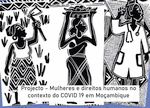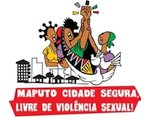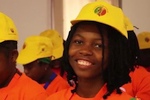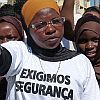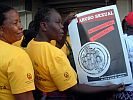Local conflict resolution bodies and the strengthening of gender roles.
The resolution of cases of domestic violence
Maria José Arthur and Margarita Mejia
The great cultural diversity in Mozambique, with the presence of different forms of social regulation finds expression, among others, in the presence of unofficial conflict resolution bodies. In addition, for the majority of the population the problems of access to the central justice system render the unofficial way the only alternative, either through the political structures or through the traditional and religious power entities.
The discussion about forms of social normativeness other than official justice, included in the large debate on legal pluralism, has been ongoing since the nineties1 and gained expression in the 2004 revision of the Constitution and in a few bills2. What has been emphasized are the governability crises, the problems of the majority of the population having access to justice, the functioning of the community courts, the possibilities of integration of “African culture” values and concepts into the legal systems (Bidaguren & Estrella, 2002); the relations between the State and the plurality of rights that form the basis of conflict resolution and that maintain social order, with the consequent lack of correspondence between the political control unit and the administrative control unit, expressed in the “fragmentation and differentiation of the State” (Santos, 2003: 48); the “illusion of the centrality” of the judicial system, when in practice the community courts are the first instance of the judicial system (Trindade; Pedroso: 2003: 316-317).
Our contribution to this debate, in the scope of the research, was to identify the role of local bodies in the management of domestic violence problems, taking into consideration the representations of the agents who operate at this level on this type of violence and the normative function of the gender relations in the family and in the community. In fact, in the scope of a new research, the aim was to study the same object already studied in previous works, during the Fourth Research Phase of WLSA, on the administration of justice and access of women to the courts of justice3.
We prefer to use the designation “local” instead of “informal” bodies. The concept of informal body implies that they are not regarded part of the legal structure of justice, which cannot be applied with propriety to the community courts, created by Law 4/92 of 6 May4. In the event, the term “local bodies” refers to those bodies functioning at community level and which are not integrated into the State justice administration system, including the community courts, the dynamizing groups, the social affairs sections, OMM, the traditional authorities and AMETRAMO (Association of Traditional Healers) or AERMO (Mozambican Association of Herbalists).
In this article we will begin with a presentation of the community courts and their articulation with other bodies at local level. Then we will discuss their functioning, highlighting the more frequent types of conflicts, and analyse the underlying gender ideology. We are concerned when observing what practices inform us about the implicit assumptions of the social order, namely of the roles and expectations regarding women and men. Finally, we will analyse the effectiveness of the intervention of these bodies for problem resolution and for interrupting the cycle of violence.
The community courts and their articulation with other local conflict resolution bodies
Notwithstanding the diversity of the bodies that at local level manage conflicts, our focus was on community courts, which are situated on the threshold between these and the judicial structures, with a clear mandate. In effect, the Community Courts were created by Law 4/92 of 6 May, following the reform of the judicial organisation, materialized by the Organic Law of the Judicial Courts, of 1992 (Law 10/92 of 6 May), emanated from the 1990 Constitution which introduced a multiparty system and recognised unrestricted political rights, laying down the principle of strict legality. In addition, according to Trindade and Pedroso (2003: 264), the new Constitution “strengthened state monopoly of the production and application of justice and, therefore, the professionalisation of justice”. All subsequent legislation in the area of the administration of justice aims at minimising “the participation of citizens and communities in the whole justice administration process”, and has extinguished the grassroots people’s courts of the judicial system.
However, the law that creates the community courts recognizes in its introduction that: “The experiences collected in the country by a justice of the community type indicate the need for their appreciation and deepening, taking into account the ethnic and cultural diversity of the Mozambican society”. It is in this sense that they are seen as:
“bodies that allow the citizens to solve small disagreements within the community, contribute to the harmonization of the various practices of justice and to the improvement of the rules, customs and habits and lead to a creative synthesis of Mozambican justice”.
The competences defined for the community courts are:
“to solve small conflicts of a civil nature and issues emerging from family relations that are the result of unions established according to customs and habits, trying to achieve, whenever possible, reconciliation between the parties” (Art. 3).
It is expected that these bodies will function in the administrative posts or localities, in the quarters or in the villages and that they will be guided by the reconciliation of the parties in conflict and, if this is not possible, “the community court will judge according to fairness, common sense and justice”. They cannot apply punishments that imply the loss of liberty. A relevant aspect is that, by law, the decisions of these courts are only binding if accepted by both parties, there always being the possibility to resort to the judicial instances to solve the conflict. In other words, the decisions of the community court will be legitimate, as long as the parties in conflict recognise this legitimacy. As indicated by Bidaguren and Estrella (2002), the aim of these courts is “to restore the relation between the parties and the community”, while the solutions and punishments are based on restitution, on compensation and on satisfaction of the offended party or on community services.
The composition of the community courts is established as comprising eight members, five of them permanent and three substitutes. Mozambican citizens not younger than 25 years may be elected for this position by the local representative bodies. The members of the community courts should elect among them the president.
Law 4/92 was intended to make a clear demarcation between the community courts and the previous People’s Courts. However, given that the respective regulation was never prepared, little or nothing has been done, so that if they in principle are part of the judicial organisation, they have been left aside, without supervision, support or training. In these conditions, in practice, many of them function as a prolongation of the People’s Courts.
The situation found during fieldwork reveals a large diversity, not only between provinces, but even within the same district. Sometimes, two community courts that function at a distance of only 20 or 30 kilometres between them have huge differences in their functioning, in the composition of their members and in the type of articulation with other local conflict resolution bodies5. In some places, inclusively, the community court became extinct due to total lack of support, because their members had died or had voluntarily withdrawn or due to competition with other forms of local conflict resolution, as will be described in more detail below. Since the new law was approved, the election of new members, as had been foreseen, has never occurred, which is the result of a lack of regulation that would operationalise the contents of the law. In the still functioning bodies we find both members of the previous people’s courts, and members indicated by the local political structures.
Through our observations we established the existence of several factors that influence the functioning of the community courts. In the first place, if there is or not continuity in relation to the extinct people’s courts, with respect to their composition. In some rural and urban community courts in the provinces studied, where there is at least one of the old members still present, there is a more regular functioning, greater knowledge of the law or greater preoccupation to know the law, and more legitimacy vis-à-vis the residents of their area of jurisdiction. When the courts only function with new members, which was also detected in several localities, there is in general a greater impreciseness regarding the functions of these bodies and their functioning.
In the second place, continuity in the political structure of the quarter also influences the functioning of the community courts. This is the case of the municipality of Beira City, where since the year 2003, with the victory of Renamo in the local elections, the quarter structures were replaced, following the previous line of their politicisation. The quarter secretaries and their advisers were indicated from among Renamo militants in the city. After assuming office, these continued the process, removing the majority of the old members who were part of the community courts and of the social affairs sections, for being OMM members or being connoted with the Frelimo Party.
Also in Sofala Province, in a rural area, quarters were found where the local structures are led by individuals who assumed power in the last 5 to 10 years, defining new priorities and destabilizing somehow the regular functioning of the previous bodies. As we will see below, both in this case and in the previous one the community courts suffered the consequences and in some cases became extinct.
Finally, other factors that may have influence are related to i) the availability of more learned people or people with greater knowledge of legislation to become part of the community courts; ii) some support, although sporadic, on the part of the judicial instances at district or provincial level.
In fact, only in Inhambane Province evidence was found of some contacts between the Public Ministry and the community courts. In the remaining provinces the scenario is rather distressing: in addition to the lack of more basic material, such as paper, pens or pencils, they never benefited from judge training activities or of other initiatives that would mean recognition of their work6. It should be noted that, though the majority of the conflicts solved at this level has to do with the family, none of the interviewed judges knew the Family Law, approved in 2004, neither did they have a copy of it.
All these aspects find expression in the various ways in which the courts articulate with the quarter authorities and with other bodies, revealing local strategies and power balances. In general, however, it is the quarter Secretary who controls the various bodies. In an extreme case, observed in a quarter of Dondo district, Sofala, it is the Secretary who performs simultaneously the function of president of the community court. As was explained to us:
Quarter Secretary: “Our link is the following: when we here receive this problem, we first see what type of problem it is. If it is a problem of a man or a woman, we channel it to [the Section of] social affairs. If social affairs are unable to solve it, or if the man or the woman resists, we transfer the problem to the community court. The court will also solve it, but if they don’t succeed, then we channel the problem to the Women’s Help Centre. The Women’s Help Centre. This is how we work”. (Interview with the secretary of the 9th Quarter, Beira, 24/05/05)
In practice, however, the process does not always work out in such a peaceful and orderly way and we may find competitive or cooperative relations. In the first case, we have situations in which the bodies compete among themselves for greater legitimacy, mutually seizing their functions. In the second case, complementariness manifests itself when the specific competences of each body are called to intervene in the resolution of the conflicts. For example, when the cases are related to sexual violence of minors the presence of OMM representatives is indispensable, or when accusations of witchcraft emerge, the support of traditional healers is requested, as was observed in the majority of community courts.
Regarding the community courts, we found that when the community courts don’t exist or are very weak, it is the Social Affairs Section of the quarter or the community policing Council, which takes upon itself the resolution of local problems. This was observed in several quarters in Beira City and in 2003. The intervention of the community policing Council in the resolution of local conflicts represents an enormous concentration of power for a body whose activity is already problematic. The “community policing system”, presented as an initiative of the Ministry of the Interior and aimed at the “approximation, collaboration and complementariness between the police and the community”7, appeared in the year 2000, and has been widely accused of gradually transforming itself into a paramilitary armed force, that has been imposing itself on the communities by the use of force. In fact, the situation found in the quarters and localities visited, showed some development of this initiative relative to the original idea. First of all, although one insists that the objective of the “community policing” is to be a way of guaranteeing the voluntary participation and collaboration of citizens with the police, and that another police force is at no moment whatsoever being formed, at local level the more current designation is “community police”. On the other hand, joining the community policing Council is not remunerated, which has been strongly contested, mainly in the cities, where a large part of its members is unemployed, expecting being able to secure some kind of payment in this way. Another aspect is that although these councils are not authorized to use or have weapons, neither to carry out detentions, these orders are constantly transgressed.
When the community policing Council intervenes in the resolution of local conflicts, as was observed in a Beira City quarter, it should be remembered that nobody has elected its members. Anyone can apply for being part of this body. They are not people recognised by the community as being competent, but the Council is open to everybody who likes to participate8.
Other situations of competition normally involve the controversy of who should deal with the cases, with the aim to impose oneself as the only legitimate and expedient body in conflict resolution. As was argued both in a Beira quarter and in a Maputo City quarter, the problem is that the payment meant for covering the costs of the process, even if sometimes very small, stirs up the interest of some bodies.
Regarding OMM, whose mediation functions, mainly in family conflicts, have been highlighted (Osório et al., 1999; Osório et al., 2001), this organisation has gradually decreased its level of intervention in the communities observed. With the exception of Maputo City, where OMM functions in an autonomous way and keeps offices for the resolution of family conflicts running, the organisation does not intervene in an autonomous way, it is rather invited to collaborate with other bodies. In the municipality of Beira, however, with Renamo in executive control, the Renamo Women’s League is present at quarter level.
The traditional healers, organized by AMETRAMO (Mozambican Association of Traditional Healers) or by AERMO (Mozambican Association of Herbalists, mainly functioning in Beira) have a strong presence at local level, being called in by the quarter structures to collaborate in conflict resolution, articulating with the community courts and with Social Affairs. However, this articulation is not always peaceful and there are visible tensions. For other bodies, however, the recognition of the intervention of healers derives, as Meneses et al. have already pointed out (2003: 410-3), from their capacity to accommodate problems such as envy or malevolence that, even while they do fall within the scope of the law, cause instability and dysfunctionality.
In general, there is an almost total predominance of men in these bodies. Although Bidaguren and Estrella (2002) state that with the opening up of democracy women and youth start to participate more actively, the situation found in the field goes in the opposite direction: female representation in the composition of the people’s courts decreased in the course of time and is almost absent today. As said above, however, OMM and Renamo Women’s League (in the case of Beira municipality) representatives are called in when there are issues involving sexual crimes against children or youth. Besides, this progressive exclusion of women as mediators, restricting them to what is thought to be their competence, is general. The quarter secretary explained that when they need them, they call in the “intelligent OMMs”9.
Mainly at the level of Beira and Maputo City, there is an articulation with the police stations and sometimes directly with the Help Centres, which receive cases that are considered exceeding their competence (e.g., qualified voluntary bodily offences) or when the parties in conflict refuse to accept the conclusions of the mediation process.
Conflict management and gender ideologies
In spite of the existence, in many quarters and localities, of tense relations between the various mediator bodies at local level, there is a consensus in conflict resolution sustained by ethics, by the law and by the legitimacy of their representatives. These positions are in the sense of “restoring” and reconstituting order, thus acting as a way of social control. In this sense, and as has already been pointed out, “the identification of conflicts in which women are involved as litigants or as offenders passes in the first place through the recognition of the ways and forms of the realization of the social construction of female identity” (Osório and Temba, 2003). It is this aspect we will discuss next, making use of the discourses of representatives of these bodies.
In the first place, we would like to emphasize, as said above, that the competence of the community courts comprises cases of a civil nature and conflicts resulting from “unions constituted according to customs and habits” (Art. 3). Thus, in principle, all problems falling within the category of criminal offences would be excluded, as well as those regarding marriages celebrated according to civil law. However, practice shows that often no distinction is made between civil and criminal matter, provided that they fall within the family sphere, as if this specific location would turn the problems into “small conflicts”. Consequently, not only are the criminal offences occurred in the family sphere not passed on to the competent bodies, but in many cases are also legitimised in the light of patriarchal values that control family organisation and hierarchies. It is in this sense that the frequent designation of “social cases” to refer to the problems solved in local bodies represents already violence committed against women, as the recognition of the civil or criminal nature of the infraction is rejected10.
Taking into consideration the whole of the local bodies, the type of cases more frequently dealt with are related to “family conflicts” or “social cases”, designations that cover what in civil and penal law correspond to: non-contribution to household expenses, lack of providing food allowance for the children, parental guardianship, division of property after the dissolution of a de facto union, domestic theft, simple and qualified physical aggression, defamation, moral offences, paternity determination processes. In addition to these, another set of problems, not considered as crimes in the law, is also brought in, namely: accusations of witchcraft, adultery or abandonment of the family11.
The majority of people resorting to the mediation of the community courts or other local bodies are women. However, although physical and psychological violence is the background against which other conflicts develop, physical aggression only very rarely becomes the basis of the complaint. More frequency physical aggression is used as an argument to give more strength to other accusations considered more “legitimate”. Basically, the same phenomenon is observed as had already been the case with the functioning of the Help Centres (Arthur and Mejia, 2005), except that, without having the law as a reference, this characteristic tends to gain more importance.
From the analysis of the explanatory theories on the part of community representatives of the eruption of conflicts and physical aggression at domestic level, we would like to highlight a few statements. In the first place, poverty and the lack of resources on the part of men are considered to lead to the contestation of their authority in the family, giving origin to dysfunctional situations that culminate either in violent behaviour on the part of the husband/partner, or in “inappropriate” attitudes of the wife/partner, for example, lack of respect, adultery or abandonment of the home.
The other statements are to a certain extent developments of this central questioning: disorder appears when women and men, but mainly women, do not conform to the roles and expectations attributed to them. Tolerance relative to “deviations of the norm” on the part of men is an implicit recognition of who has the power to rewrite them, maintaining however the same gender hierarchy and inequalities.
The second statement relates the work of women outside the domestic sphere as bringing disorder, because women start to socialize with men without the mediation of the family group, causing justified jealousy on the part of their husbands/partners; on the other hand, when it is the woman who sustains the husband/partner because he has no work, she feeds expectations of the continuity of a shared life, which defrauds many of them.
Next, although polygamy is legitimated and accepted, it is sometimes seen as disturbing, when the man does not have the power to manage his houses or if it is practised outside tradition, adopting the form of “amantism” [love outside a recognised union]. The same concerns are expressed relative to the unions that are celebrated outside tradition, which would lead to a taking away of responsibility from the parents of the couple and from their relatives.
Finally, another statement relates the instability of the marriage with the “natural” wish of men to have many women.
The perception of equal rights between women and men and knowledge of the law
An issue that interested us was to know how the discourse of equality between women and men, initially presented in the form of “emancipation of women” and later on as an emphasis on the equality of rights, has been picked up and is being presented. We should not lose sight of the fact that we are talking about claims of subordinated groups, with the potential to destabilize some hierarchies. From the statements made by local authorities and representatives of several bodies, it was possible to identify three positions that run through a wide spectrum. The first one is of total refutation of the discourse of equality, by the reassertion of the “traditional” values, even when these are possibly contemporary recreations. It should be noted that sometimes this discourse equally reasserts male responsibilities in relation to the family, also criticizing those who transgress their roles.
The second position seeks to reconcile the principle of gender equality with local values and traditions. This is not so much a process of “indigenization”12 of the discourse on human rights, but mainly its recreation, a hybridisation that preserves the local values as hegemonic, although incorporating a few new elements. At the same time, this position criticizes the radicalism of the new ideas and presents them as the cause of the eruption of domestic conflicts.
The last position is clearly one of challenging the patriarchal model, contesting the male prerogatives and the mechanisms of control of women. These very direct positions were only expressed by women, the majority of whom with a long political experience in OMM.
Still in connection with the perception of equality of rights, we sought to identify which parts of civil legislation were known and applied in the resolution of domestic conflicts. It was found that, in spite of these bodies not having the respective legislation at their disposal, the majority has a reasonable knowledge relative to some principles, namely regarding parental guardianship, alimony right, inheritance and property sharing:
- Parental guardianship and alimony rights – the principle is that children of up to 7 or 10 years should stay with the mother, the father having to contribute with a food allowance to support the subsistence of the child.
- Inheritance – there is recognition of cases of usurpation of the inheritance of widows and children on the part of the husband’s family, when he dies. The position has been to protect the rights of the woman and her descendants, while at the same time trying to quiet the other part of the family, as may be confirmed by the following testimony.
- Property sharing – the principle of property sharing in the case of dissolution of a de facto union is almost never contested. There are however different interpretations regarding how and in which conditions it should be applied.
However, we are aware of the fact that the processes rarely occur in such a transparent way. On the same occasion, in which the above testimony was collected, another court member explained that a woman has only a right to property sharing if the man has left the house. In the opposite case, when the woman has ended the union, she should not have a right to anything, because it is not fair to take the “property of the husband” and then “give it to another one”.
In addition to these aspects where there is a basic knowledge of the law, other aspects are more problematic, such as the violation of a minor and physical aggression (bodily offences). In fact, both cases, as they are of a criminal nature, should immediately be channelled to the police authorities, which dos not always happen, as we will see below.
Perceptions about the expectations of the victims who resort to local bodies and the aggressors
In this section we intend to explore, on the one hand, the perceptions of the individuals who are part of the local conflict resolution bodies about the expectations of women who approach them to solve their problems and, on the other hand, how the aggressors are perceived. One of the questions we want to raise is if the type of expectations may originate the victim’s decision to resort to the police or the local bodies.
Regarding the first issue, it was possible to identify some aspects that show great similarity with the expectations of women who approach the Help Centres for Women and Children in the police stations: i) the complaint represents a request for support to solve a problem and the aim is neither to punish the aggressor nor the dissolution of the marriage/union; ii) the accusation normally concerns questions considered socially legitimate, although the relation in which she lives is almost always very violent; the exception is when the level of violence is high and falls in the category of “unjust”; iii) many of the women withdraw the complaint and one of the reasons is their fear of new aggressions from their partner or his relatives.
It should first and foremost be noted that the search for a conciliation combines perfectly with the perspective that guides the mediation activities of local bodies, which seek to reconcile the parties in conflict. The victims who resort to these bodies want to improve the situation in which they live and have peace at home, without for that reason appear as a woman who denounces her husband. They think that this body may be socially more accepted than the police and that therefore revenge of the husband and his family is less justified.
In spite of this, as we saw above, there is great similarity between what the women who try to find a solution to their problems at local level expect and those who approach the Help Centres, so that we would like to suggest that other factors also influence the choice of one way or the other: proximity and the ease of access to the police stations and the recognition of the legitimacy of these entities. The women who directly approach the police stations or Offices are criticized.
Regarding the judged men, these are considered guilty when they do not fulfil their obligations as family heads. The male privileges and prerogatives are not questioned, but they are rather called to “order”. The nature of the functioning of this body has facilitated that some men who have complaints about the behaviour of their wives always resort to it, with the aim that they will be advised to return to “good” behaviour.
Perspectives on domestic violence against women and the effectiveness of breaking the cycle of violence
Faced with the high incidence of violence against women in the scope of interpersonal relations at domestic level, we question ourselves about the role of local bodies in containing this kind of violence. An analysis of the data shows that physical aggression is not seen as a crime, but rather justified by the lapse of the wife. And in spite of the claims that the criminal problems are channelled to the police authorities, in practice this does not happen.
The problems are judged and the situations evaluated from their own values and beliefs, normally in agreement with society and the hegemonic patriarchal values. This reveals itself, for example, when in the analysis of the cases there is interference from values such as the “good” and the “bad” behaviour of the people concerned. Their evaluation is ruled by conformity with the traditional gender roles that model the socially accepted female and male behaviour.
Thus, the results show that the use of force on the part of men in the resolution of conjugal conflicts is seen as legitimate, which is then solved through a caution, of the two partners, so that they will respect the prevailing norms about the family and the recognized rights and duties according to gender roles and hierarchies. The effectiveness of this advise is doubtful, as everything seems to indicate the existence of a constant recurrence of aggressions, in spite of the commitments assumed by the agressor13. The security of the victim who lodged the complaint is also not guaranteed.
Conclusions
An analysis of the material suggests that these bodies function according to codes of conduct rooted in the social constructions of so-called common sense and which are not necessarily foreseen in the laws, neither in the principle of equality of rights between men and women. The common sense of the agents that work in these bodies reflects mainly the representations of the organisation of the society to which they belong, respecting the socially established gender roles and power relations, accepted by the majority. These values are neither counterbalanced by a systematic training of the agents nor by control of the application of legality. The last election of judges of the current community courts was held in 1987 and only recently the first training courses for this target public have started, in the Centre for Legal and Judicial Training. The mechanisms to replace the judges who meanwhile are no longer active depend on each locality, but they are more frequently indicated by the local administrative authorities or the secretary of the dynamizing group (Negrão et al., 2002). Regarding the OMM offices, there have been some training activities when they were created in the nineties, but after that the activities of these agents has not been integrated.
- See Soares and Trindade (orgs), 2003, Bidaguren and Estrella, 2002.
- See “Lei de Bases da Organização Judiciária” and “Anteproposta de Lei Orgânica dos Tribunais Comunitários”; both bills are ready for discussion and approval by the Council of Ministers and may be consulted at the website of the Legal Reform Unit. (website no longer exists).
- See: Osório and Temba, 2003; Osório et al., 1999.
- This issue is raised by Negrão et al., 2002, who think that up to a certain point these courts may be considered an “official”, instance, “in the sense of having been created by normative legislation”.
- This enormous diversity in the situation of the community courts has been confirmed by previous and more exhaustive studies on the same issue, such as Bidaguren & Estrella (2002) and Gomes et al. (2003).
- It should be noted that during fieldwork we had some material produced by WLSA with us, such as pamphlets about the Family Law and others with legislation applicable to the resolution of conflicts of domestic violence, as well as posters with several messages about women’s human rights. This material was offered at quarter level but unfortunately we were unable to respond to all requests, mainly for pamphlets about the law.
- Annual Information of His Excellency the President of the Republic, Joaquim Alberto Chissano, to the Assembly of the Republic, on the General Situation of the Nation, “The challenge of the construction and consolidation of the State”, Maputo, 10 April 2003.
- After the massive adhesion of men and women at the moment of their constitution, only those who had no work and were expecting to find in this way a permanent occupation remained. The women were the first to abandon the Council. This issue deserves greater analysis, though it does not fall within this report. Preliminary information leads us to understand the existence of a process of exclusion led by a group that came to impose itself and started to dominate the Council.
- Mafambisse, Sofala, 7/6/05.
- Besides, the same is discussed with regard to the performance of the police officers in service in the Help Centres for Women and Children in the police stations.
- We avoid using the original expression that is “abandonment of the home”, as this is the designation of the crime of lack of the provision of family support, foreseen in Law nº 2053/1958.
- In the sense given by S.E. Merry, who defines “indigenisation” as “the way according to which new ideas are integrated and presented in the terms of existing norms, values and practices” (2006: 39).
- At the end of counselling the spouse or partner who recognises being guilty of the problem writes (or simply signs) a declaration committing himself to change behaviour. As we will se below, this is a practice that was retrieved by the Offices functioning in the police stations, also in the scope of their counselling functions.
References:
Lei Orgânica dos Tribunais Judiciais, de 1992 (Lei nº 10/92 de 6 de Maio)
Lei da Organização Judiciária de Moçambique, de 1978 (Lei nº 12/78 de 12 de Dezembro)
Anteproposta de Lei de Bases do Sistema de Administração da Justiça.
ARTHUR, Maria José; MEJIA, Margarita (2005), O funcionamento dos Gabinetes de Atendimento da Mulher e da Criança. Entre lei e moral social.- In: Outras Vozes, nº 12.
BIDAGUREN, Jokin Alberdi; ESTRELLA, Daniel Nina (2002), Governability and forms of popular justice in the new South Africa and Mozambique. Community courts and vigilantism.- In: Journal of Legal Pluralism, 47. pp. 113-135
GOMES, Conceição; FUMO, Joaquim; MBILANA, Guilherme; SANTOS, Boaventura de Sousa (2003), Os tribunais comunitários.- In: B.S. Santos e J.C. Trindade (org.), Conflito e Transformação Social: Uma Paisagem das Justiças em Moçambique, Vol II.- Porto: Afrontamento. pp.189-340.
MENESES, Maria Paula; FUMO, Joaquim; MBILANA, Guilherme; GOMES, Conceição (2003), As autoridades tradicionais no contexto do pluralismo jurídico.- In: B.S. Santos e J.C. Trindade (org.), Conflito e Transformação Social: Uma Paisagem das Justiças em Moçambique, Vol II.- Porto: Afrontamento. pp. 341-450.
MERRY, Sally E. (2006), Transnational human rights and local activism: mapping the middle.– In: American Anthropologist, 108 (1).- pp. 38-51
NEGRÃO, José et al. (2002), O papel dos Tribunais Comunitários na prevenção e resolução de conflitos de terras e outros. – Maputo: FAO – Projecto GCP/MOZ/069/NET.
OSÓRIO, Conceição et al. (2000), A ilusão da transparência na administração da justiça.- Maputo: WLSA Moçambique.
OSÓRIO, Conceição et al. (2001), Poder e violência. Homicídio e femicídio em Moçambique.- Maputo: WLSA Moçambique.
OSÓRIO, Conceição; TEMBA, Eulália (2003), A justiça no feminino.- In: B.S. Santos e J.C. Trindade (org.), Conflito e Transformação Social: Uma Paisagem das Justiças em Moçambique, Vol II.- Porto: Afrontamento. pp. 165-188.
ROBERTS, Simon (1998), Against legal pluralism. Some reflections on the contemporary enlargement of the legal domain.- In: Journal of Legal Pluralism, 42.- pp. 95-106
SANTOS, Boaventura de Sousa (2003), O Estado heterogéneo e o pluralismo jurídico. – In: B.S. Santos e J.C. Trindade (org.), Conflito e Transformação Social: Uma Paisagem das Justiças em Moçambique, Vol I.- Porto: Afrontamento. pp. 47-128.
TRINDADE, João Carlos; PEDROSO, João (2003), A caracterização do sistema judicial e do ensino e formação jurídica.- In: B.S. Santos e J.C. Trindade (org.), Conflito e Transformação Social: Uma Paisagem das Justiças em Moçambique, Vol I.- Porto: Afrontamento. pp. 259-318.
* * *







 Information in English
Information in English